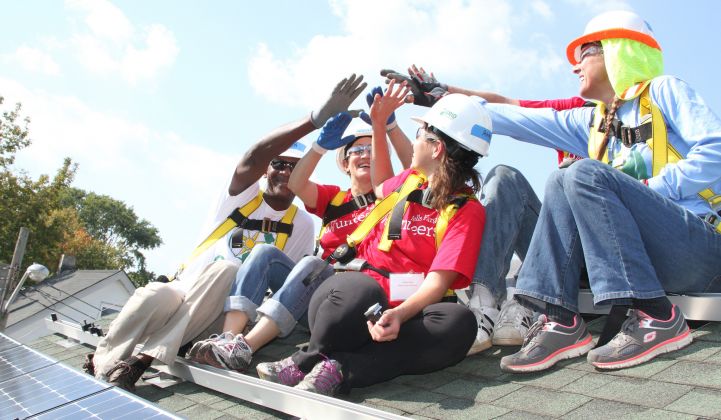The White House announced a series of actions this week that will make it easier for low-income households to invest in energy efficiency and solar, with a goal of 1 gigawatt of solar for low-income residents by 2020.
One of the most significant parts of the Clean Energy Savings for All Initiative is the additional guidance on property-assessed clean energy financing (PACE) for single-family homes.
PACE programs allow investments in water- and energy-efficiency retrofits and distributed renewable generation to be paid back through property taxes, which lowers risk for both lenders and owners and can potentially open up a far larger swath of the energy-efficiency market.
Currently, residential PACE is active in two states. California makes up the lion’s share of the $2 billion market, but No. 2 Florida is growing as well.
Last year, the White House took the first step to open up residential PACE to the rest of the nation by providing additional guidance that required PACE liens to be subordinate to Federal Housing Administration single-family-home first-mortgage financing.
Now, the FHA has announced that properties with PACE loans can be purchased and refinanced with an FHA-insured mortgage. Last year, FHA products represented more than 20 percent of mortgage originations at purchase and 13 percent of refinancings.
For low-income homeowners interested in energy efficiency or solar, this helps remove the barrier of upfront costs. Also, the FHA has the broadest credit box of any publicly backed mortgage product, so it will expand the access of solar and energy-efficiency upgrades to more homeowners, according to Ari Matusiak, EVP of market development and external affairs for Renovate America.
Renovate America is the clear leader in residential PACE with three-quarters of the market. To capture the momentum of the announcement from the White House, Renovate America and Vivint Solar announced a partnership to offer Renovate America’s PACE loan program to Vivint Solar customers.
“We are excited to work together with Renovate America to provide this innovative solar financing product that will make solar available to a wider range of consumers, including those who either do not have the upfront capital for a solar energy system or for whom traditional loans, power-purchase agreements or solar system lease agreements are not viable options,” Thomas Plagemann, Vivint Solar’s EVP of capital markets, said in a statement.
PACE should open up some availability for single-family homeowners, but community solar should also get a boost after this week’s announcement.
“Community solar is going to be, in the very near future, one of the strongest vehicles for low-income access to renewables and energy savings,” said Stan Greschner, VP of government relations and market development at Grid Alternatives, which has developed a policy guide on low-income households' access to solar. “But it is not going to be a panacea for low-income participation.”
There are initiatives already underway by the U.S. Department of Housing and Urban Development to expand the availability of solar energy. HUD expanded its goal of renewable energy on federally subsidized housing last year to bring 300 megawatts of renewables to low-income housing units by 2020. That goal includes community and shared solar installations. With this week’s announcement, more than 120 housing authorities and rural electric co-ops are investing a total of $287 million to install community solar in 36 states.
There are currently community solar projects spread across 27 states, according to GTM Research, with project development activity in a further nine states. Community solar is important for those who do not own their own homes or who lack suitable roofs for solar, both of which should benefit the low-income segment.
But states will have to be careful to craft community solar projects that are inclusive. People will still need the money to purchase a subscription, something that can be overcome with a portion of each project being set aside to go to low-income residents.
Community solar is also a ripe opportunity to bring customers into low-income energy efficiency programs, said Greschner. “There’s a smart way to connect the two,” he said. He noted that some leading states like California and New York already have those types of provisions in their community solar programs. To help kick-start community solar projects with a focus on low-income neighborhoods, the DOE is developing a community solar challenge with prizes of up to $100,000 for innovative community solar projects.
For most of the U.S., there is much work to be done. “There are still major barriers in all markets, especially where there are new solar markets being created,” said Greschner. “But [these initiatives] reorient the clean energy conversation to one that should include solutions for the hardest-to-reach communities.”



